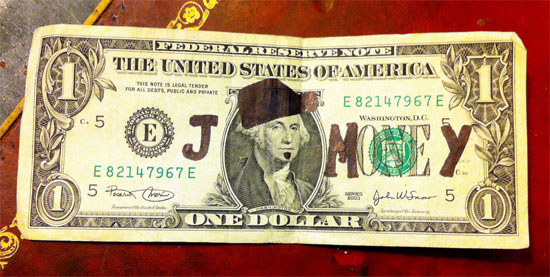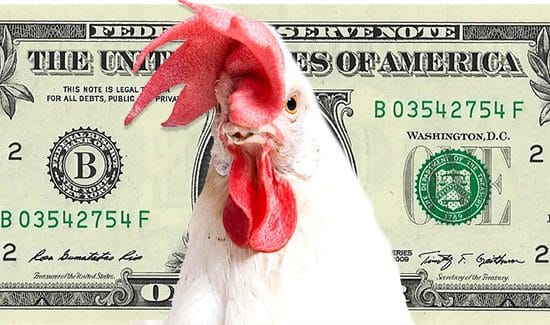Last week on our net worth update post, a good blogger friend of mine, Joe @ Retire By 40, pointed out the fact that sometimes it’s easier to look at the percentage of a drop in money vs the stone cold dollar amounts. Since a 1% drop is a lot less scarier than, say, a $5,000 loss. (Or in my case last month, an $11,000 loss). And I pretty much agree with that.
On the flip side though, the same can be said for INCREASES. It’s much sexier to see a $5,000 increase in cash than a measly 1% bump – at least when it comes to me. So if you’re averse to feeling the stress or sting of a situation, you’d need to flip flop the way you perceive situations.
Personally, I prefer to see the cold hard dollar amounts every single time with both the good and the bad. I NEED that solid punch in the gut (or emotional high-five!) every time I see an update as it keeps me *motivated*. Whether with my net worth, paying my taxes, or even following our debts. The numbers don’t have a filter – they tell you how it is. There’s no softening a $100,000 loss or gain like it would be by changing it to a %. $100,000 is a $100,000 either way you look at it! For both the good and bad.
After commenting back to my ol’ friend Joe about this (albeit a lot more condensed), I started thinking about the other stuff I prefer to see these hard numbers on too over a percentage. Is it only in regards to my finances? Does it differ if the situation’s not pertaining to me specifically? What are the other areas in life are we confronted with actual numbers vs %’s?
These are the things that go through my mind on a typical day :) I thought long and hard about it (TWSS!), and this is what I came up with…
The areas I’d rather see the cold numbers than %’s:
- My net Worth (obv)
- Raises
- Debts
- Stocks
- Taxes (nothing makes you appreciate the amount you pay in taxes like mailing the IRS a physical check yourself! One of the shockers of learning to be self-employed…)
- Paychecks ($2,000 check vs. 4.17% of your salary. Hah!)
- Amount saved at the grocery store (“You saved $15.35 today!” vs.”You saved 19%!”)
- And pretty much anything else relating to my personal finances.
And these, for whatever reason, are the instances I’d prefer seeing %’s:
- Sales signs! ($50% off today!)
- Amount of goal completion
- Amount of something being downloaded
- Pie charts. You can never go wrong with pie charts.
It’s an interesting exercise to try if you have the time one day. Or when you’re just plain bored at work – like perhaps right now as you’re reading this? ;) We’re used to dealing with percentages and hard numbers every single day of our lives, but to consciously think about which we prefer more, and why (and in which situations?) is kinda neat to do. Tells you a little more about yourself and how you like to cope with different situations.
If you had to guess, which route do YOU prefer when dealing with money? The cold hard dollar amounts, or the tinier, softer, % marks? Or are you just a hustler and not phased in either event? ;)
—————-
[Photo by James Cridland / Tweaked by J$]
Get blog posts automatically emailed to you!





I’m very much a percentages man, as I believe that when we are looking at the hard figures, we are subconsciously thinking about the percentage anyway.
For example, if my shares lose $1,000 and my net wealth is $5,000, I’m a lot more bothered than if my net wealth was $20,000.
I’m only looking at the number, but the $1,000 impacts me much more in the first example. Why? Because, even though its a cold, hard number, I have already translated it automatically into a percentage of what I’m worth.
Therefore, I find it easier just to skip a stage and work at everything in percentages.
This is even more important when it comes to ROI calculations on investment decisions etc. I’m making a $1,000 a month from an investment. Well, that is much better if its on a $2,000 investment than on a $100,000 investment.
In short, percentages for the win!! :)
*grin* I have to tell you:
Sales signs! ($50% off today!)
“hurt” seeing both made me … twitch … for a moment “50 US Dollars percent off today! ”
I prefer hard numbers for most things… Percents can hide so many sins, especially in statistics (plus/minus five percent can be plus/minus 250000 entries)
Exactly! % can mean a lot of different things.
So call me what you will, but I need to see both the hard numbers and the percentages. If say my grocery store receipt only shows the amount in $ that was saved I will have to also calculate the percent that was saved. If something only shows the % I will have to calculate the dollar amount. I need/must have both!
I prefer hard numbers, mostly because you can figure out the percentages yourself if you want to see them. However, I’m with you on seeing losses, the percentage makes those -$15,000 days more bearable.
1% may not seem like a large increase, but if you have a 1% increase every month, you are on track for a 12% increase for the year, which is not bad at all.
Yeah but what does 1% equal? $10.000? $100,000? If someone told me their net worth increased by 1$ or even 10%, I still have no idea how much money we’re actually talking about here. Now *after* I know the basis of what we’re dealing with, then sure – much easier to put in perspective. I guess to me it’s just no as *impactful* talking about a % vs hard cash numbers.
I would argue it is more important to have a high return than the actual dollar amount. The dollar amount will almost always be related to the amount you have invested. If you don’t have much, then you will not likely make or lose much, but if you have a lot already, then your losses or gains will be much more. If you gain $1,000 in a month, but you have $1,000,0000 you didn’t do as well as someone who gained $500 after starting with $100,000. It might seem better to gain $1,000, but that is only .1% in our example versus the .5% gain for the second example. Anyway, we could go on and on. I get your point, to a point. ;-)
haha… And I get your point, to a point, too :) good discussion.
Hard numbers for me. Percentages can sometime be misleading, certainly when you are looking at data collected over a loner period of time.
I like seeing percentages with goal completions too!!!! I use smarty pig and I love it with that cute little pig is 99% full and I know I just have to throw a little bit more money at it to reach my goal. If you have no idea what I’m talking about, this comment is probably really weird. ;)
Haha… I didn’t know they were actually still around? Haven’t heard much buzz about them like I used to.
I would be more interested on seeing the exact amount than percentages because you’ll know immediately how much you lose or earn. If you see percentages, you’ll have to compute it before knowing how much it really is.
Haha true. Who wants to do double the work? :)
I want them both as both are essential for context. If I tell you my Schwab account dropped $1k last month, is that a big deal because I blew it all on 1 trade or is that simple market fluctuations on a $100k portfolio. Knowing the percentage provides the context. Likewise someone in their 20’s just starting out could double their net worth over the course of a year, while if my net worth went up 100% that could have a very different meaning. The jump from $5k to $10k is meaningful. The jump for me would be life altering.
For sure. Context is very good so having both is ideal.
I’ll have to sit on the fence on this one and say ‘it depends.’ For micro, day-to-day things like cost of coffee, lunch, charity, etc I prefer to see the dollar amounts. For the macro, big picture things line debt repayment, retirement, e-fund, etc. I prefer to see the percentage change. I think it is much easier to comprehend large figures as percentages but thats just me. Also, when there is a market correction and my retirement accounts drop 3%, that scares me a lot less than if I actually see the dollar amount it went down…
Cold dollar. Reality sucks but there’s no need to try to hide the losses from ourselves IMO. Also a 100% increase would sound insanely positive when dealing with smaller numbers.
What about weight? I bet people like the cold hard number when losing weight and the % when gaining weight, lol.
I’d probably agree :)
I switch back and forth between % and $$. I like percentages with stocks for long term planning and looking back. I used to love and hate seeing dollar numbers on days with big moves. Like “wow, I made $500 today” or “crap, $1,000 down the drain.”
Now I am almost strictly an index fund guy, so I don’t pay as much attention to the daily stuff although when I do check it, I still look to see how much I “made or lost that day” in cold dollars.
Thanks for the mention! I still like seeing the % better with net worth. % gives you a more complete picture. You know how you did last month in comparison to your overall NW. :)
Seeing both is even better though.
They definitely both have their place in looking at finances. % is very good when you need to take into consideration the original amount. It is very easy to argue hard numbers to make your case but when % are used, they can be put into perspective. I’ll usually use both when looking at my finances, they give me a whole picture to look at.
The hard numbers! When I see percentages I’m always calculating how much that is anyway. So save me some trouble!
I’m greedy – I have to have both. Just one won’t due.
Well luckily you can have your wish in most cases :)
Hard numbers! Straight up. Percentages can mean so many things and to a certain point can be misleading. Ever wonder why most marketing specialist use percentages? It can do wonders to make something look good or look bad to the advantage of the person using it. However I have to agree with some of the commenters that there are indeed instances that there’s a need for both to be able to come up with a better perspective and make decisions too.
I’ll have to agree with your statement 1800% more than the one before it ;)
I’m all about the cold, hard dollar amounts since I need the swift punch to the gut to keep myself motivated too. :-)
I was thinking about current savings accounts rates these days, and this blog post of yours came to my mind. Percentages really help put things into perspective. I’ll give you a few examples from my own recent experiences.
Current savings accounts rates all over the nation are at anemic levels, usually 1% at best, and averaging a painfully measly .06% (according to CNN Money, Oct. 2013, http://money.cnn.com/2013/10/01/pf/savings-account-yields/). Through my cash back credit cards (yes, I pay them off in full every month) I’m earning ~4% on my spending (yes, my SPENDING)! That’s significantly better than anything I can get in a savings account right now.
Another example. I just recently signed up for Capital One’s Black Friday promotion, offering $75 for funding a savings account with $500 (or more of course), and $125 for opening a checking account and making 5 debit purchases within 45 days of opening. That $75 for $500 ends up being a 15% return on my investment! It’s rare these days to get that kind of return. And if I use my new debit card to make five $4-$6 purchases buying coffee at Starbucks (which I plan to do) I’ve just earned a HUGE return on my money. Let’s say I spend about $25 at Starbucks with my new debit card. That’s a 500% return on my investment when I get that $125 bonus!
Last example. As some people have noted in here, the stock market has done unusually well this year. In the long run, stocks will return 7%-8%. But this year, there have been months where my 403(b) has posted double digit returns, as high as 15%! Not too shabby at all!
I can definitely see the reason why people prefer the cold hard numbers. They prefer the “gut punch” of the loss, or the fantastic high of the gain. But to me, these mean little when not compared through the scrutinizing eye of percentages.
Haha, you know what’s funny about your examples here? They all made me appreciate cold hard numbers even more ;) A 500% return or 4% cash back/etc are all sexy – I agree 100% (ya see what I did there?), but to me it just doesn’t feel *as* good as $125 or $36 or whatever the numbers are. It’s like when I find a penny on the ground one day, and the next a quarter. Percentage people would LOVE to see a 2500% difference! But to me, it’s still only 25 cents, haha… (now for manipulation reasons I’d TOTALLY go with %’s as they paint a more drastic picture, but for my own cold cash I’ll stick w/ the numbers…)
I guess at the end of the day we’re all drawn to one side or the other more for whatever reason. But having BOTH numbers and percentages makes it even *better*.
Thanks for stopping by, brotha. Really enjoyed reading this :)
Hahaha! I laughed pretty hard at your first comment about how my argument made your appreciate the cold hard numbers even more. You’re totally right. At the end of the day, it just simply comes down to whatever floats your boat. And indeed, analyzing both the numbers and the percentages does give the most robust picture of what’s going on.
Thanks for keeping up a great personal finance blog! I always enjoy seeing what J$ is up to.
Thanks man, have a blessed holiday over there, okay?